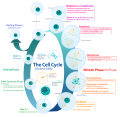The origin and function of meiosis are currently not well understood scientifically, and would provide fundamental insight into the evolution of sexual... 25 KB (3,262 words) - 07:31, 25 December 2022 |
 | Meiosis (/maɪˈoʊsɪs/ ; from Ancient Greek μείωσις (meíōsis) 'lessening', since it is a reductional division) is a special type of cell division of germ... 62 KB (7,299 words) - 08:27, 9 April 2024 |
Plant reproduction (redirect from Sexual characters of flowering plants) evolutionary origin and adaptive significance of sexual reproduction are discussed in the pages Evolution of sexual reproduction and Origin and function of meiosis... 25 KB (3,263 words) - 13:37, 30 March 2024 |
 | Spermatogenesis (category Meiosis) Germ cells Male infertility Meiosis Oncofertility Oogenesis Origin and function of meiosis Sertoli cells Sexual reproduction Semen analysis de Kretser... 33 KB (3,722 words) - 17:15, 21 January 2024 |
Advanced maternal age (redirect from Age and infertility) recombinational repair (see Origin and function of meiosis). Human primary oocytes are present at an intermediate stage of meiosis, that is prophase I (see... 31 KB (3,189 words) - 00:01, 12 April 2024 |
 | Oogenesis (category Meiosis) Evolution of sexual reproduction Female infertility Female reproductive system Meiosis Oncofertility Oogonium Oocyte Origin and function of meiosis Sexual... 30 KB (3,472 words) - 14:19, 16 April 2024 |
 | spores by meiosis, a process which reduces the number of chromosomes to half, from two sets to one. The resulting haploid spores germinate and grow into... 40 KB (4,567 words) - 04:09, 7 October 2023 |
 | H., Bernstein, C. Evolutionary origin and adaptive function of meiosis. In "Meiosis", Intech Publ (Carol Bernstein and Harris Bernstein editors), Chapter... 80 KB (9,740 words) - 04:10, 22 April 2024 |
theory of aging DNA repair DNA replication Free radical damage to DNA Homologous recombination Meiosis Mutation Natural competence Origin and function of meiosis... 79 KB (9,956 words) - 11:19, 14 March 2024 |
 | Sex (section Adaptive function of sex) haploid sex cells called gametes via meiosis, each of which has a single set of chromosomes. Meiosis involves a stage of genetic recombination via chromosomal... 63 KB (7,041 words) - 04:47, 24 April 2024 |
 | Chromosomal crossover (category Modification of genetic information) different theories on the origin of meiosis. The first theory rests upon the idea that meiosis evolved as another method of DNA repair, and thus crossing-over... 32 KB (3,708 words) - 13:34, 2 March 2024 |
 | during meiosis than mitosis. In meiosis, absence of a chiasma generally results in improper chromosomal segregation and aneuploidy. Points of crossing... 6 KB (702 words) - 05:27, 23 February 2024 |
 | Sperm (redirect from Evolution of sperm) spermatocytes then undergo meiosis, reducing their chromosome number by half, which produces spermatids. The spermatids then mature and, in animals, construct... 30 KB (3,388 words) - 21:19, 21 April 2024 |
 | Nondisjunction (section Meiosis II) failure of a pair of homologous chromosomes to separate in meiosis I, failure of sister chromatids to separate during meiosis II, and failure of sister... 25 KB (2,847 words) - 00:44, 9 February 2024 |
 | Reproduction (section Mitosis and meiosis) contain half the number of chromosomes of normal cells and are created by meiosis, with typically a male fertilizing a female of the same species to create... 31 KB (3,442 words) - 19:09, 16 February 2024 |
 | Sexual reproduction (category CS1 maint: DOI inactive as of March 2024) produce haploid cells in a process called meiosis. In meiosis, DNA is replicated to produce a total of four copies of each chromosome. This is followed by... 38 KB (4,777 words) - 23:40, 28 March 2024 |
 | Eukaryote (redirect from Origin of eukaryotes) group's common ancestor. A core set of genes that function in meiosis is present in both Trichomonas vaginalis and Giardia intestinalis, two organisms... 61 KB (6,029 words) - 18:37, 23 April 2024 |
 | Amoeba (section Early history and origins of Sarcodina) Rad51, Rad52, Mnd1, Dmc1, Msh and Mlh. This finding suggests that the ‘'Acanthamoeba'’ are capable of some form of meiosis and may be able to undergo sexual... 41 KB (3,651 words) - 12:52, 17 April 2024 |
as the original diploid parent cell. Meiosis only occurs in cells of the sex organs, and serves the purpose of generating haploid gametes such as sperm... 249 KB (21,545 words) - 19:09, 24 April 2024 |
 | Mating (redirect from Animal Courtship and Mating) that function in meiosis and that are widely present among sexual eukaryotes. These results suggested that G. intestinalis is capable of meiosis and thus... 14 KB (1,394 words) - 19:42, 21 March 2024 |
 | Saccharomyces cerevisiae (category CS1 maint: DOI inactive as of January 2024) these cells undergo meiosis to form haploid spores. Evidence from studies of S. cerevisiae bear on the adaptive function of meiosis and recombination. Mutations... 72 KB (8,418 words) - 04:27, 5 February 2024 |
 | Mutation (redirect from Loss-of-function mutation) result from errors during DNA or viral replication, mitosis, or meiosis or other types of damage to DNA (such as pyrimidine dimers caused by exposure to... 117 KB (13,965 words) - 23:04, 22 April 2024 |
 | H., Bernstein, C. Evolutionary origin and adaptive function of meiosis. In "Meiosis", Intech Publ (Carol Bernstein and Harris Bernstein editors), Chapter... 72 KB (7,324 words) - 01:03, 14 April 2024 |







